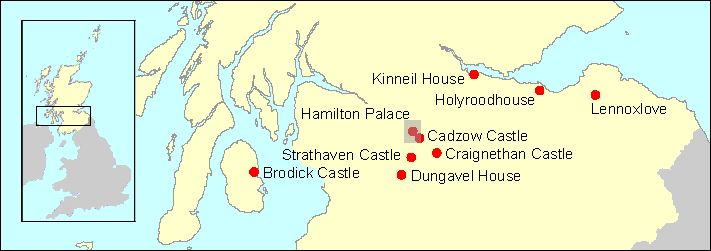 |
||||||||
|
Hamilton Palace (site), Hamilton, South Lanarkshire
|
||||||||
 |
||||||||
|
This map is reproduced from Ordnance Survey material with the permission of Ordnance Survey on behalf of the Controller of Her Majesty's Stationery Office © Crown copyright 2003. Any unauthorised reproduction infringes Crown copyright and may lead to prosecution or civil proceedings. RCAHMS GD03135G0011.2003 |
||||||||
|
A powerful and widespread family, whose main branch is acknowledged as the premier peerage of Scotland, the Hamiltons first appear on record in the late 13th and early 14th centuries in the form of Walter fitz Gilbert 'of Hameldon'. Between 1315 and 1329, he was granted the barony of Cadzow by King Robert I, and by early the following century at least, a version of his name, probably derived from a place in Northumberland, had come to be applied to the lordship. The family established close links with the royal dynasty through the 1st Lord Hamilton's second marriage in 1474 to Mary Stewart, a daughter of King James II, and widow of Thomas Boyd, Earl of Arran. Reaching a new zenith in the turbulent second quarter of the 16th century when James Hamilton, 2nd Earl of Arran (d.1575), was Lord Governor of Scotland, the family's considerable power and prominence continued to make itself manifest in the succeeding centuries. Thanks to the richness of the family archives, it is possible to gain a much more intimate appreciation than is normal of the daily domestic life of a family of such national standing, well portrayed in The Days of Duchess Anne (1973, 2nd 2000), a detailed account by Rosalind K Marshall of life in the household of the [3rd] Duchess of Hamilton (1632-1716). This map shows a selection of the principal properties in central Scotland which are, or have been, associated with the Hamiltons over the centuries, stretching from Brodick Castle on Arran in the west to Lennoxlove in the east. The baronies of Cadzow and Kinneil (Bo'ness, West Lothian), together with Mauchline in Ayrshire (not indicated), formed the nucleus of Walter fitz Gilbert's reward for loyalty in the Wars of Independence, and the family subsequently accumulated much land from the forfeitures of recalcitrant noble families such as the Black Douglases and the Boyds. In the 20th century, uncertainties about the upkeep and stability of Hamilton Palace prompted the family to move firstly to Dungavel House, south of Strathaven, where they lived until after World War II, and then to Lennoxlove in East Lothian. The shaded area over Hamilton Palace corresponds to a pair of more detailed maps. The map does not show, among other things, the properties in London which the family has enjoyed since at least the 17th century. Indeed, it was in a duel in Hyde Park in 1712 that the 4th Duke of Hamilton was killed, together with his opponent, having just the previous year had conferred upon him by Queen Anne the English titles of Duke of Brandon, Suffolk, and Baron Dutton, Cheshire. |
||||||||
|
|
|
|
|
|
|
|
|
|
 Detailed
maps of the Hamilton area Detailed
maps of the Hamilton area |
 Detailed
view of the palace Detailed
view of the palace |
|||||||
|
|
|
|
|
|
|
|
|
|
